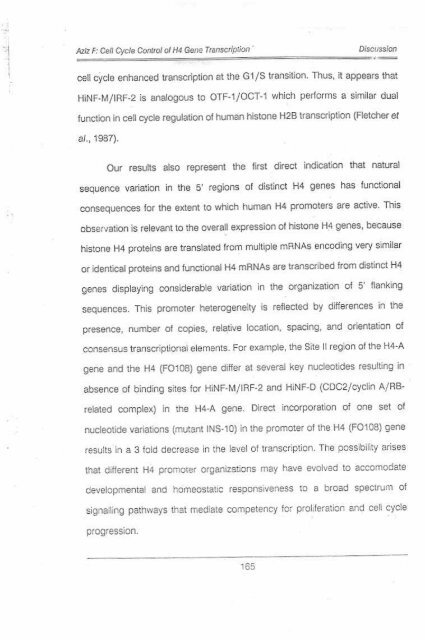Page 1 \ ?^p 6r.1 CELL CYCLE CONTROL OF HUMAN H4 ...
Page 1 \ ?^p 6r.1 CELL CYCLE CONTROL OF HUMAN H4 ...
Page 1 \ ?^p 6r.1 CELL CYCLE CONTROL OF HUMAN H4 ...
You also want an ePaper? Increase the reach of your titles
YUMPU automatically turns print PDFs into web optimized ePapers that Google loves.
I<br />
azz F Con CYb Cnror ot <strong>H4</strong> G@e ntns.ldion<br />
cell cycLe enhanc€d transc ption al the G1/S lransiton Thus, at app€ars that<br />
HiNF-M/|RF-2 is analogous to oTF-1/ocTn which pedorms a simil* dual<br />
lunction in cel cycle regulalion ol human histone H2B transc ption (Flelcher el<br />
a/.,1987).<br />
Ou rcsulls also rcpr€s€nt the li.sl direct indication that natural<br />
sequ€nc€ vaiation in the 5 regions ol dislinct <strong>H4</strong> 96n€s<br />
has lunctional<br />
consequences lor lh€ exent to which human <strong>H4</strong> promoteE are aciive This<br />
observation is rolevanl to the overall expression ol hislono <strong>H4</strong> genes' bocauss<br />
hi$one <strong>H4</strong> proleins are lranslaled trom mLrltiple mFNAs encodlng very smilal<br />
or idernicsl proteins and tunclional <strong>H4</strong> mRNAs are lranscribed lrom distincl <strong>H4</strong><br />
genes displaying considerable variation in |he organizallon ol s' ilanking<br />
sequences. This promoter heterogeneity is .eflect€d by ditierences in lhe<br />
presence, number ol copies, relalive location spacing' and orientaton or<br />
consensus ta.scriptional elemenls. Forexample, the sit6llregion olih€ <strong>H4</strong>_A<br />
gene and rhe <strong>H4</strong> (FO1O8) gene dille. al seve.al kev nucleotides .esulting in<br />
absenc€ of bindlng sites lor HINF-!|/IRF_2 and HiNF-O (COC2/cvcln A/RB'<br />
related complex) in the <strong>H4</strong>.A gene. oirect jncorporation oi one set ol<br />
nucleotide !€riations (mutant INS'10) inthe promoler ol lhe <strong>H4</strong> {FO108) gene<br />
results in a 3 iold decrease in the evel oi lranscripton The posslblity arises<br />
thal diilerenl <strong>H4</strong> P.omole. organizaiions may have evolved to accomodale<br />
deleopmenta and homeostalc responsive.ess ro a brcad spectlm ol<br />
slgnaling pathways that med ate competency<br />
r65<br />
'ar<br />
prolleral on and ce I cycle

















